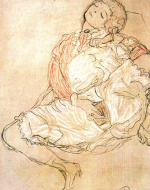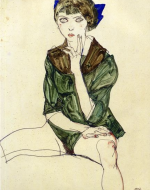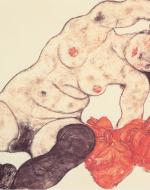Created by Kate Yoder on Mon, 02/26/2024 - 16:33
Description:
Display Explanation
Upon entering the exhibition, viewers would find themselves in a small medium yellow-colored room with a cream ceiling and deep brown wooden floors. The lighting would be slightly dim, with no central lighting fixture. Instead, the viewers would find themselves seeing cone-shaped light fixtures containing single yellow-orange tinted bulbs that change brightness at certain times of day to accentuate one of the three paintings. Each painting would be inside of a mustard yellow frame that would be carved into a simple shape and have simple patterns and embellishments within it. Furthermore, each painting would be vertically centered on the wall, but be slightly above where it would also be horizontally centered. This draws the viewer’s eyes up and makes the presentation better follow the “rule of thirds.” This setup only invites one viewer at a time, encouraging them to put themselves in a seemingly uncomfortable room for an experience they will have. Each person who steps into the room will see the painting that they are meant to see (depending on the lighting) and will be invited to explore what stage of metamorphosis they are in, whether it be sexual, emotional, or physical.
On the left wall would be Gustav Klimt’s Woman Masturbating. The small nature of the piece would make it seem less overwhelming and powerful compared to the other two. If the light is bright on this piece, it showcases a startling scene of this woman pleasuring herself and sets the scene for the sexual freedom and further expression that comes with the other two pieces. Paired with the fact that the subject is looking up, almost as if looking into the light, it makes the piece a perfect starting point.
The back wall would showcase Egon Schiele’s Sitting Woman in a Green Blouse. In this work, the woman stares straight at the viewer. If the lighting is bright, her gaze is accentuated and seems more domineering. If the lighting is dim, it is more renounced and loses its power. This piece fits the best on the back wall because of her facial expression and the fact that she seems bored of having people look at her.
Last, but certainly not least, is Schiele’s Sitting girl on the right wall. When the lighting is strong, it creates an incredibly domineering and controlling piece that wants to steal the viewer’s gaze away from the other two. Looking away from the viewer and to the right (towards the wall where the door will be) suggests that the woman is looking for a new person to enter and restart the cycle anew and begin their journey of self-discovery.
Each painting would have a tiny placard indicating its title, year, and artist, but other than that there should be nothing else in the room. There would be no windows, and no music in the background to accompany the pieces. The works are to serve as an individual story and journey, and having outside distractions would take away from their message of sexual freedom and self-acceptance. Any of the pieces are a starting point for the viewer, and the order in which they are viewed will create a unique path for the audience to dive into their internal selves.
Installation Note
Metamorphosis depicts the sexual journey of three women as they display their different levels and variations of sexual comfort and freedom. The artists of these pieces, Schiele and Klimt, are known for their pieces of the female figure and for showing them in sometimes obscene or graphic ways.
Klimt’s Woman Masturbating shows a woman that is fully clothed, even wearing shoes, but exposing her vagina to the viewer. She seems to be lying down, and her legs are spread open to face the viewer. Accompanied by her closed eyes and peaceful facial expression, she is aware that she is being watched, and doesn’t care. Her arm is accented with a bright red, further drawing attention to where her hand is. No background and the neutral cream of the paper gives the woman more room to exist. There are no limits as to where she could be or who her audience is, further showing her ability to claim and hold down space in the piece.
The woman in Sitting Woman in a Green Blouse is simultaneously more exposed and covered than the woman in Klimt’s piece. Her green blouse and blue hair ribbon are pops of color that give more insight into this woman’s personality and make her seem more youthful. Similar to the previous work, her legs are spread so the viewer can easily see between them, but she is covered up by a slim piece of her blouse. She is not afraid to expose herself in a more mellow way and seems to be working up the courage to show her full body. Her face shows a questioning and thoughtful demeanor, almost as if she is bored of being observed and wants to continue to show off on her own accord. The blank background further supports this, almost giving an airiness to her and proposing that her mind is empty at this moment. She’s posing, but her nature and expression don’t allow her to assume power and space as Klimt’s subject does.
Sitting girl boasts a fully nude woman in a seemingly uncomfortable pose. She is only wearing stockings and is holding her red clothing. Discarding the color to show off her body suggests that she wants to be seen for her natural self and body, not because of the clothes she wears or the vibrant colors she has. Red accentuates her breasts, elbows, cheeks, and lips suggestively, indicating that she might have had sex recently. Her eyes are looking off into the distance because there is no need to look at the viewer. She is likely nervous, given that all of her curves and skin are being shown to an audience. Unlike the other two pieces, the background color isn’t the same as the skin tone. The background proves her humanity because she has a more realistic skin tone that includes various colors. This piece has the most varying color out of the three, which further adds to this point. She feels the most human to the viewer because there's color in her face and body as well as her clothes. The other two pieces only had clothing with color, but this woman has come to life because her body is incredibly detailed.
Going based on clothing alone, these women expose themselves to varying degrees. As we analyze further, we see the contradiction between Klimt’s subject pleasuring herself with all of her clothes versus Schiele’s being completely nude and almost anxious to be on display. These women are brave to be exposing themselves to the public eye and show that sexuality is an extremely intricate thing and that everyone feels differently about themselves and their bodies.
Klimt, Gustav. Frai bei der Selbstbefriedigung (Woman Masturbating). 1913. https://en.wikipedia.org/wiki/Gustav_Klimt#/media/File:Klimt_Mulher_sent.... Accessed 13 Feb 2024.
Schiele, Egon. Sitting girl. 1917. https://en.wikipedia.org/wiki/Egon_Schiele#/media/File:Egon_Schiele_-_Weiblicher_Akt_mit_gelbem_Handtuch_-_1917.jpeg. Accessed 13 Feb, 2024.
Schiele, Egon. Sitting Woman in a Green Blouse. 1913. https://www.wikiart.org/en/egon-schiele/sitting-woman-in-a-green-blouse-1913. Accessed 13 Feb 2024.
Copyright:
Associated Place(s)
Featured in Exhibit:
Artist:
- Multiple Artists




